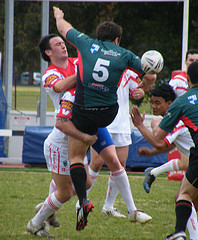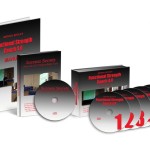Introduction
If you are a sports physiotherapist that manages athletes that compete in contact sports, then I am sure that you have treated contact or collision related injuries. Now sports physiotherapists who work with rugby league will take specific note and interest with this research. Do not despair if you do not work with rugby league, you may have experience working with similar contact sports such as rugby union. If not…well… then you have permission not to read this post or read a little about Rugby League here (but remember it is a pretty interesting one). This post discusses new research on physical collisions in professional rugby league and their impact on injuries.
Additionally, it allows me to post some videos of some incredible rugby league hits.
To The Research
Gabbett and colleagues (2011) evaluated the physical collisions (both attacking and defensive) suffered by 51 professional rugby league players (from the same team) over 3 seasons. In every game te physical collisions, both attacking and defensive were classified as:
Defensive
1. Tackles
2. Missed Tackles
3. Ineffective Tackles (could not prevent offload)
Attacking
1. Tackled in Possession
2. Broken Tackles
3. Offloads
4. Support Runs
5. Decoy Runs (contact at the line)
Additionally, the team was split into four groups. These were:
- Hit-up forwards (props)
- Wide running forwards (second row and locks)
- Adjustables (hookers, halfbacks, fiveeighths, and fullbacks)
- Outside backs (centres and wing)
Finally the injuries sustained by these groups (which must have been as a result of the collision) were classified as (Gibbs, 1993):
- Minor (1 match missed)
- Moderate (2–4 matches missed)
- Major (5 or more matches missed)
What Did They Find?
The study found some very interesting results. Given the tendency for multiple defenders to tackle one attacker, each player was involved in a significantly greater number of defensive than attacking collisions (19 vs 13). As you would expect forwards underwent more physical collisions than the backs (38 vs 25). Now as for each group, the number of collisions was highest in wide running forwards (47), followed by hit-up forwards (36), adjustables (29) and finally outside backs (24).
Yeah, well this is exactly what I would expect, so what is interesting? Great question!
Over the 3 seasons a total of 48 collision injuries were sustained. Attacking collision injuries were more common than defensive, most likely given that multiple defenders will collide with one attacker. Interestingly, the wide running forwards had the lowest incidence of collision injury, and the outside backs the highest. In fact, the collision injuries sustained by the adjustables and outside backs groups were about 3.5 fold higher than those sustained by the wide running forwards. Hmm, interesting.
So Why Should Physiotherapists Care About This Research?
The data found by these researchers has significant bearing on the sports physiotherapists who either deal exclusively with rugby league athletes, or have contact with them in their clinic.
Firstly, musculoskeletal injuries are extremely common following collisions, so this is something you will see regularly (Gissane et al., 1995; Gabbett et al., 2004). This study serves as a preliminary ‘epidemiological’ study of injury rates and patterns in rugby league following physical collisions.
Secondly, the data identifies ‘at risk’ populations within rugby league teams. Quite obviously the outside backs are at increased risk of contact injury, and therefore this warrants specific injury prevention programs aimed at this population. Whilst clearly further research is warranted, identification of modifiable risk variables (e.g. techniques and skills) rather than unmodifiable risk variables (e.g. anthropometric characteristics) are key to the successful implementation of injury prevention strategies.
Finally, this has clear implications for return to play planning and assessment. As a result of the data supplied here you will have an idea of what physical demands are placed on an athlete in a given position. For example, if you are planning a return to play of a wide-running forward following a shoulder injury you will know that this individual must be able to withstand approximately 47 physical collisions within the 80 minute game. This has the potential to deliver incredbile specificity to your RTP assessments.
Limitations of This Study
There are quite a few identifiable limitations of this study. Firstly, this follows only one team (of 51 players) over a period of 3 seasons. This would suggest only a small sample size and there is significant room for bias, given that this one team will have differences from others e.g. playing style, coaching staff, medical team etc. Also the study only included collision injuries that resulted in a missed game and therefore a large number of lower severity injuries that resulted in missed training sessions may have been overlooked.
Regardless, this study serves as a great insight into the modern game of rugby league. What are your thoughts? Be sure to let me know in the comments or catch me on Facebook or Twitter
Photo Credit: Paddynapper
References
Gabbett TJ. Incidence of injuries in junior and senior rugby leagueplayers. Sports Med 2004;34:849–59.6.
Gabbett TJ, Jenkins DG, Abernethy B. Physical collisions and injury in professional rugby league match-play. Journal of Science and Medicine in Sport 2011;14:210–215
Gibbs N. Injuries in professional rugby league: a three-year prospective study of the South Sydney professional rugby league football club. Am J Sports Med 1993;21:696–700
Gissane C, Jennings D, Jennings S, et al. Physical collisions and injury rates in professional Super League rugby. Cleve Med J 2001;4:147–55.7. Brewer J, Davis J. Applied physiology of rugby league. Sports Med 1995;20:129–35.
Related Posts









